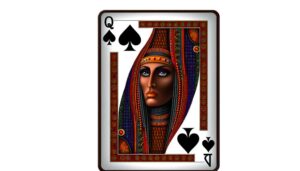What Is the Smiley Face Symbol’s Cultural Meaning?
The smiley face symbol, introduced by graphic designer Harvey Ball in the 1960s, initially aimed to boost employee morale. Over time, it has become a universal representation of joy and positivity, transcending cultural and linguistic barriers.
Early civilizations used similar motifs, indicating its ancient origins as a symbol of happiness and goodwill. The digital revolution further cemented its status through emojis, enhancing emotional communication online.
Recognized globally, the smiley face is integral to interpersonal connections, fashion, and art, promoting collective well-being. To grasp its profound societal impact and potential future adaptations, deeper exploration is warranted.
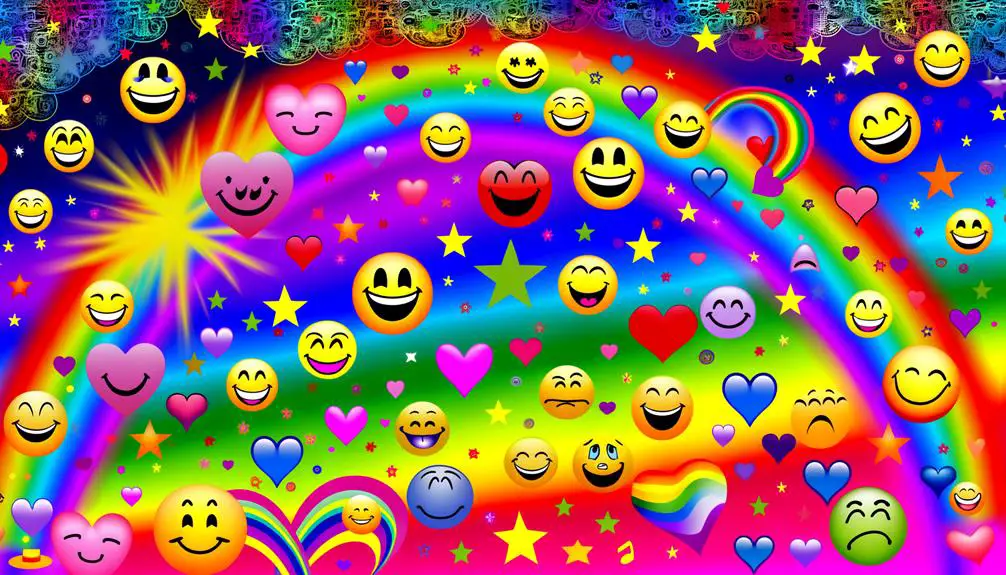
Key Takeaways
- The smiley face symbolizes happiness, goodwill, and optimism across cultures.
- Created in the 1960s, it represents mid-20th-century American positivity and transcends linguistic barriers.
- Emojis transformed the smiley face into a cornerstone of digital communication, enhancing emotional expression online.
- Its presence in fashion and merchandising showcases its enduring cultural relevance and broad appeal.
- The smiley face fosters communal harmony and individual happiness, contributing to mental well-being and social connections.
Origins of the Smiley Face
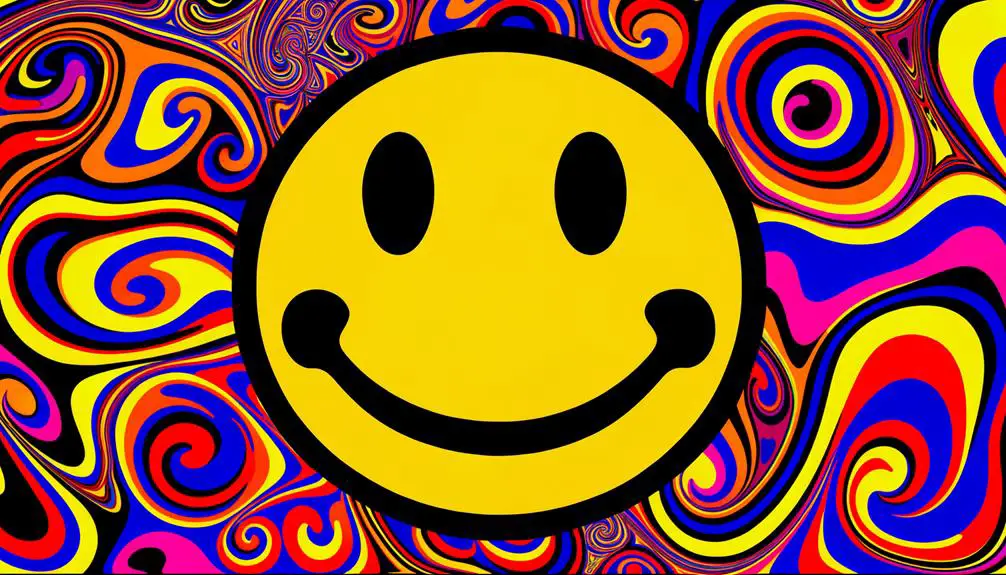
The smiley face, a ubiquitous symbol of happiness and positivity, traces its origins back to the early 1960s when graphic designer Harvey Ball created it for an insurance company's morale-boosting campaign.
Ball's design, characterized by its simple, circular form with two black dots for eyes and an upturned semi-circle for a mouth, was intended to foster a positive work environment. Contextually, this design emerged during a period marked by societal shifts and increasing corporate awareness of employee well-being.
Ethnographically, the smiley face encapsulates mid-20th-century American optimism, reflecting a cultural inclination towards visual symbols that could transcend linguistic barriers. Its minimalist aesthetic and universal appeal facilitated its rapid adoption, embedding it deeply within contemporary visual lexicon.
Early Cultural Impact
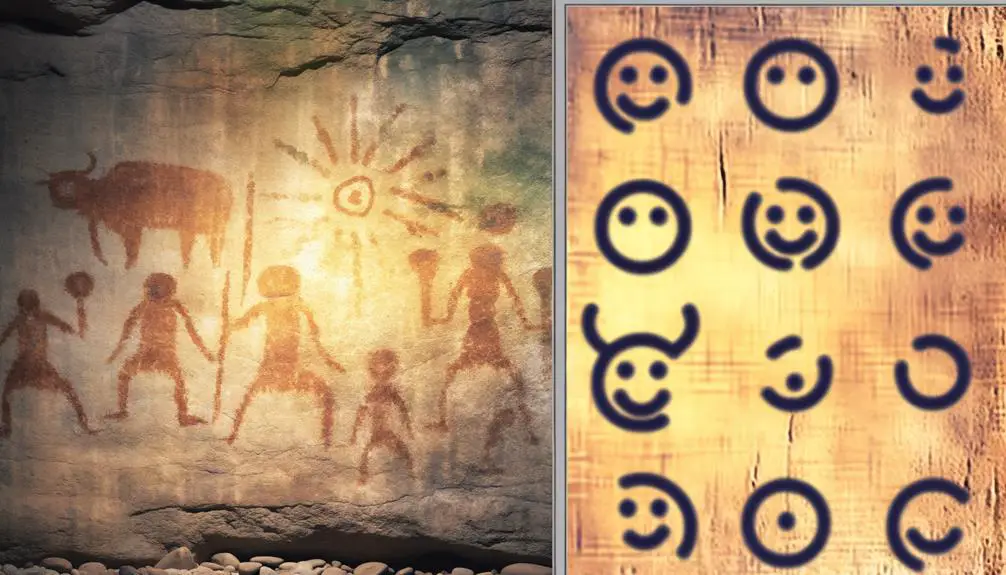
The early cultural impact of the smiley face symbol can be traced to its ancient symbolic origins, where similar motifs appeared in various civilizations as tokens of joy and goodwill.
Cross-cultural interpretations further enriched its significance, with societies around the globe adapting the symbol to fit their unique cultural narratives.
Its presence in early media, from print to visual arts, underscores its role in shaping collective social consciousness and emotional expression.
Ancient Symbolic Origins
Emerging from the depths of ancient civilizations, the smiley face symbol can be traced back to early iconography that served as a universal representation of joy and goodwill. Ancient cultures often utilized simplistic, circular forms to convey positive emotions, which were reflected in a variety of artifacts and artistic expressions.
Key examples include:
- Mesopotamian Clay Tablets: Featuring circular designs believed to denote happiness and prosperity.
- Egyptian Hieroglyphs: Utilizing facial expressions in their symbolic language to depict emotions such as joy.
- Mesoamerican Pottery: Incorporating smiling faces in their ceremonial objects to invoke benevolent spirits.
These early instances illustrate the innate human desire to visually communicate positive feelings, laying the foundational imagery that would evolve into the modern smiley face.
Cross-Cultural Interpretations
Building on these ancient foundations, the smiley face symbol evolved through various cultural lenses, each imparting unique interpretations and significance.
In certain East Asian cultures, the smiley face conveyed a sense of communal harmony and social cohesion, aligning with values rooted in Confucianism.
Conversely, in Western cultures, it often represented individual happiness and personal well-being, reflecting the more individualistic nature of these societies.
Indigenous cultures sometimes imbued the smiley face with spiritual significance, linking it to ancestral spirits or cosmic forces.
This cross-cultural interpretation highlights the symbol's versatility and its capacity to transcend cultural boundaries, adapting to diverse societal norms and values while maintaining its core essence of positivity and goodwill.
Early Media Presence
In the early 20th century, the smiley face began to seep into various forms of media, serving as a visual shorthand for positivity and commercial appeal. This emergence marked the symbol's evolution from a simple doodle to a cultural icon.
Its early media presence can be categorized as follows:
- Advertising Campaigns: Companies utilized the smiley face to evoke a sense of happiness and trust, enhancing brand identity.
- Comics and Cartoons: Artists integrated the symbol to express joy or light-heartedness, making it a staple in humorous contexts.
- Merchandising: The smiley face was imprinted on products ranging from clothing to stationery, capitalizing on its broad appeal.
These early media integrations laid the groundwork for the smiley face's enduring cultural impact.
Digital Revolution
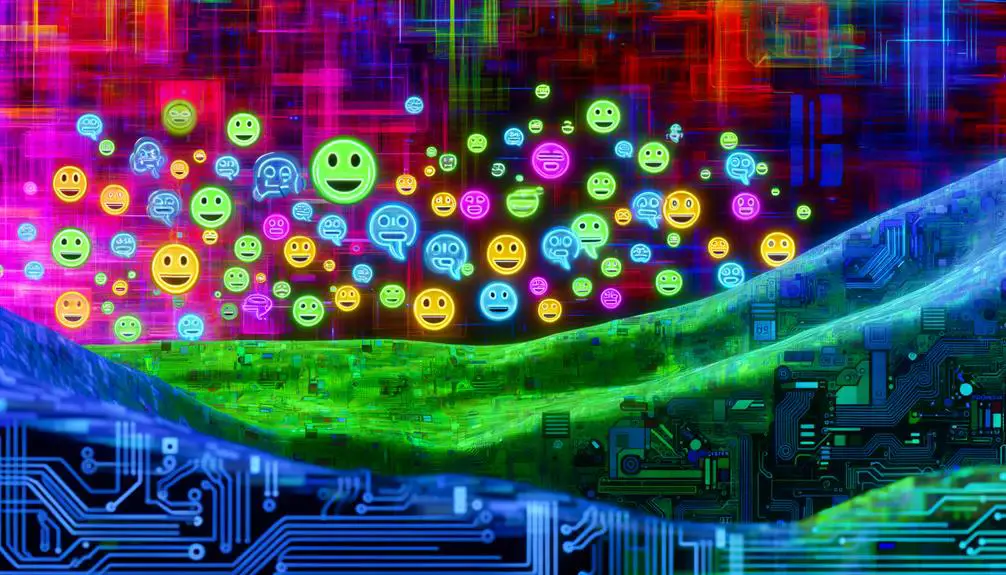
The digital revolution has fundamentally transformed the smiley face symbol, propelling it from a simple graphic to a cornerstone of emoji communication.
As online expression trends evolved, the smiley face became an essential tool for conveying emotion and nuance in digital interactions.
This shift underscores the symbol's adaptability and enduring relevance in a rapidly changing technological landscape.
Emoji Communication Evolution
How did the shift from traditional text-based communication to the widespread use of emojis revolutionize our digital interactions?
The evolution of emojis has fundamentally transformed the way we convey emotions, context, and nuances in digital communication.
This transformation can be analyzed through three key aspects:
- Emotional Expression:
Emojis allow users to express emotions more vividly than plain text, bridging the gap left by the absence of vocal tone and body language.
- Cultural Resonance:
Emojis have created a universal visual language that transcends linguistic barriers, fostering global communication.
- Efficiency:
By condensing complex messages into simple icons, emojis enhance the speed and clarity of digital conversations.
Through these lenses, emojis have not only enriched personal interactions but have also influenced broader communication practices in the digital age.
Online Expression Trends
Building upon the transformative role of emojis in digital communication, the digital revolution has further catalyzed diverse trends in online expression, reshaping how individuals and communities interact in virtual spaces. This era has witnessed the emergence of new visual languages, such as GIFs and memes, which serve as culturally resonant tools for conveying complex emotions and social commentary.
Social media platforms have become fertile grounds for these trends, enabling real-time, multimodal interactions that transcend linguistic barriers. Additionally, augmented reality (AR) filters and virtual avatars offer personalized experiences, reflecting users' identities and preferences.
Ethnographically, these trends illustrate a shift towards more dynamic, participatory modes of communication, highlighting the evolving interplay between technology and human expression.
Symbol of Positivity

As a globally recognized icon, the smiley face symbol serves as a powerful representation of positivity, transcending cultural and linguistic barriers to convey happiness and goodwill. Its simplicity and ubiquity make it an ideal medium for fostering emotional connections.
Ethnographically, the smiley face's impact is evident in various societal contexts:
- Interpersonal Communication: Reinforces social bonds by adding a touch of warmth to everyday interactions.
- Public Spaces: Enhances communal environments, such as parks and schools, promoting a sense of collective well-being.
- Workplace Culture: Boosts morale and fosters a positive atmosphere, contributing to employee satisfaction and productivity.
These elements illustrate the smiley face's role as a universal symbol of positivity, enriching human experiences across diverse settings.
Fashion and Merchandising
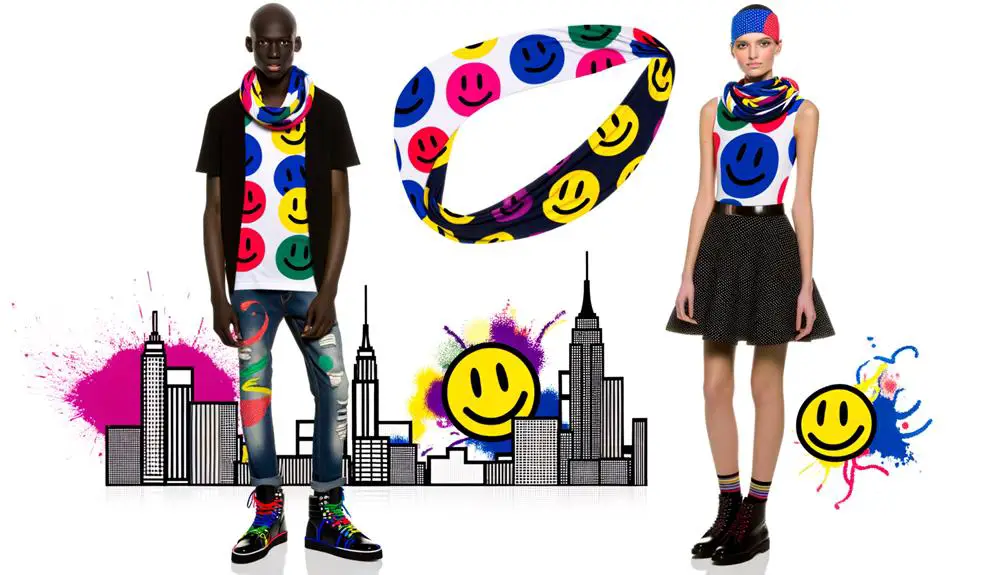
In the world of fashion and merchandising, the smiley face symbol has evolved into a versatile and enduring brand element that appeals to a broad demographic spectrum. Its simplicity and universal recognition make it an ideal choice for designers and marketers aiming to convey positivity and approachability.
The symbol's adoption by various fashion subcultures—from streetwear to high fashion—illustrates its adaptability and cross-market appeal. Ethnographically, the smiley face has transcended its origins, becoming a global icon that resonates emotionally with consumers.
Its presence on apparel, accessories, and promotional goods underscores its commercial viability. This widespread utilization speaks to the smiley face's power to connect diverse audiences, making it a staple in contemporary fashion and merchandising strategies.
Artistic Interpretations
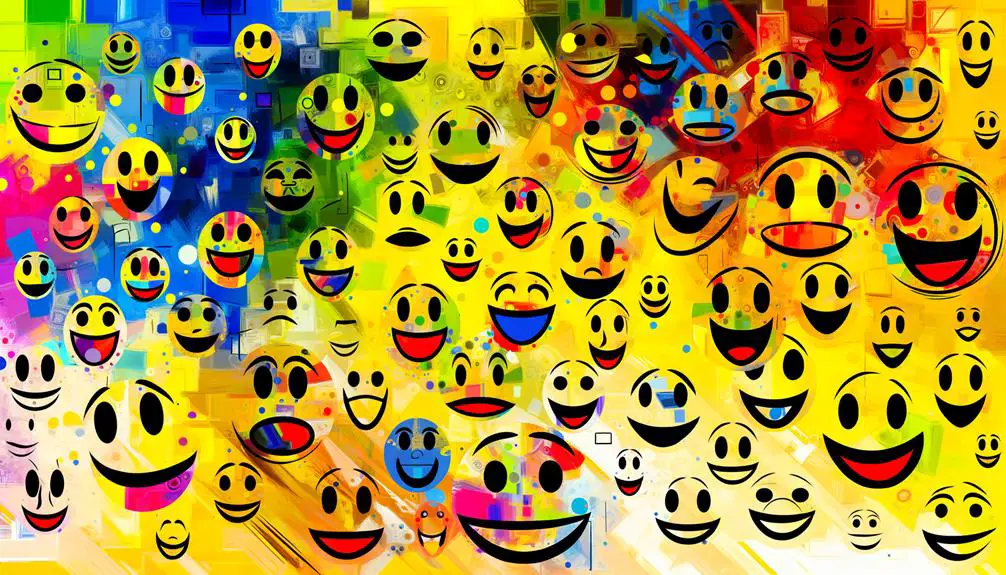
How has the smiley face symbol, originally a simple graphic, become a profound subject of artistic interpretation and cultural commentary?
Artists have appropriated this ubiquitous emblem to explore themes of identity, consumerism, and societal norms. Through various mediums, the smiley face has been transformed, subverted, and recontextualized, often juxtaposed with complex narratives.
- Identity: Artists like Yayoi Kusama have integrated the smiley face into their work to question the nature of self and collective consciousness.
- Consumerism: Banksy's use of the smiley face critiques capitalist culture, turning a once benign symbol into a commentary on materialism.
- Societal Norms: Murakami's incorporation of the smiley face in his 'Superflat' movement challenges traditional Japanese art and societal expectations.
These artistic interpretations highlight the symbol's evolving cultural significance.
Psychological Effects
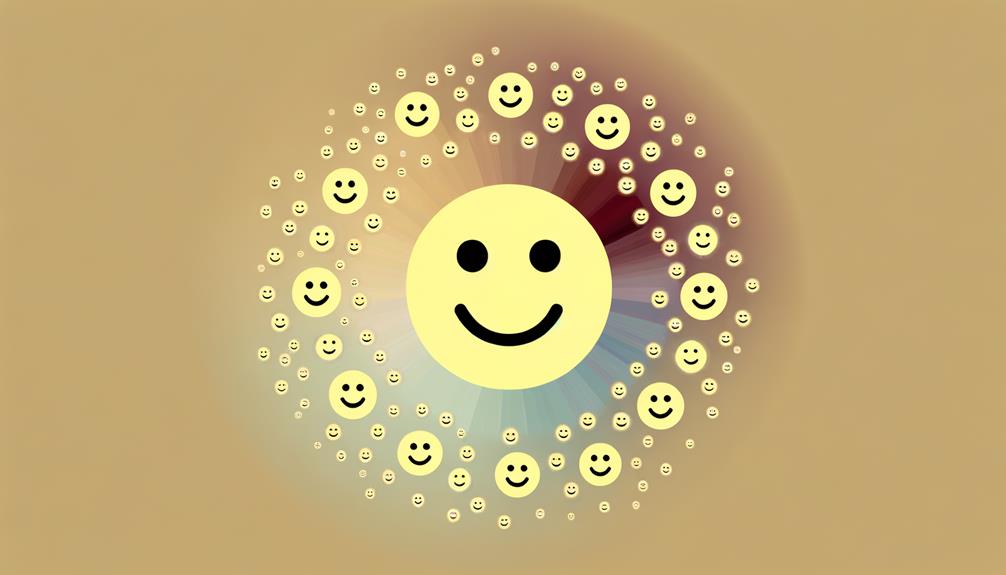
The diverse artistic interpretations of the smiley face symbol also underscore its significant psychological effects on individuals and societies. This ubiquitous emblem transcends cultural boundaries, often eliciting immediate emotional responses such as happiness and comfort.
Ethnographic studies reveal that the smiley face fosters a sense of belonging and communal positivity, especially in digital communication. Contextually, it serves as a visual shorthand for friendliness and approval, reducing social anxieties and enhancing interpersonal connections.
Analytical perspectives suggest that this symbol's simplicity and universality make it a powerful tool in mitigating stress and promoting mental well-being. Therefore, the smiley face operates not merely as an artistic motif but as a potent psychological agent that influences collective emotional landscapes.
Future of the Smiley Face
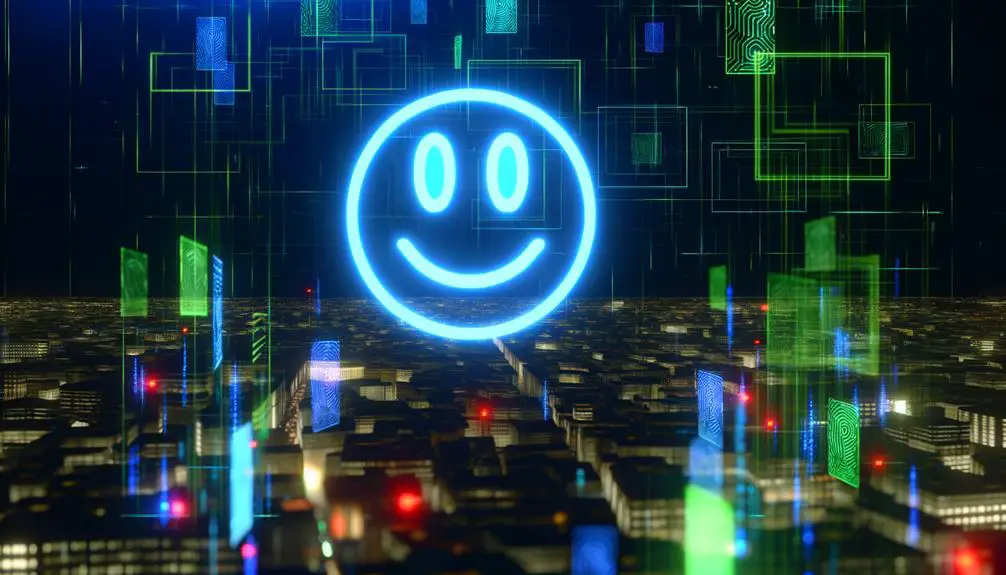
Given its pervasive influence and adaptability, the future of the smiley face symbol is poised to evolve alongside technological advancements and shifting cultural dynamics. As digital communication continues to grow, the smiley face will likely integrate with emerging technologies, creating new modes of expression and connectivity.
Observing this evolution ethnographically, three key developments can be anticipated:
- Augmented Reality (AR): Smiley faces could be embedded in AR experiences, enriching virtual interactions.
- Artificial Intelligence (AI): AI could personalize smiley faces, adapting them to individual preferences and emotional contexts.
- Cultural Integration: New variants of the smiley face may emerge, reflecting global cultural diversity and bridging cultural gaps.
These trajectories suggest a future where the smiley face remains a dynamic and inclusive symbol.
Conclusion
The smiley face, a seemingly simple symbol, has woven itself into the fabric of global culture, reflecting societal shifts and technological advancements.
From its humble origins to its ubiquitous presence in digital communication, this icon has become a beacon of positivity and commercial success.
Its artistic reinterpretations and psychological impacts further underscore its enduring significance.
As society evolves, the smiley face will unquestionably continue to adapt, remaining a timeless symbol of human connection and shared joy.

